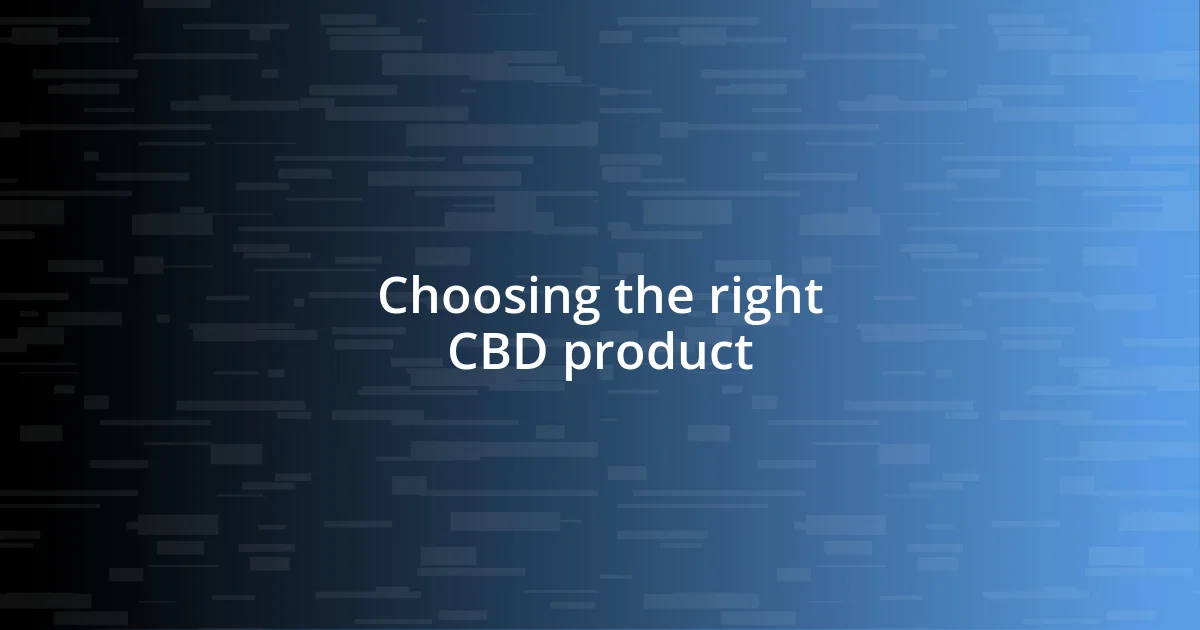Key takeaways:
- Chronic pain impacts both physical capabilities and emotional well-being, leading to feelings of isolation and frustration.
- CBD can offer a gentle relief from pain by interacting with the endocannabinoid system, potentially enhancing quality of life without severe side effects compared to traditional medications.
- Finding the right dosage and product involves personal experimentation and monitoring, which can help individuals effectively manage their pain while incorporating CBD into their daily routines.

Understanding chronic pain challenges
Chronic pain is an invisible burden that many people bear, and at times, it feels like carrying a weighted blanket that you can’t take off. I remember days when even simple tasks like getting out of bed or cooking a meal felt monumental. Have you ever had a moment when you wished the pain would just turn off for a while? That longing is something I think many chronic pain sufferers can relate to.
Navigating daily life with chronic pain means confronting not just physical limitations but emotional challenges as well. I’ve found myself feeling isolated, grappling with a sense of frustration and even guilt for not being able to engage in activities I once loved. How does one maintain a sense of normalcy when faced with such barriers? The struggle often leaves us reflecting on our identity and how pain reshapes it.
Additionally, the unpredictability of chronic pain turns simple plans into exercises in flexibility and disappointment. There were times I had to cancel outings with friends, and the sadness of missing out lingered long after the pain had subsided. Have you ever felt that gnawing fear of what might prevent you from enjoying life’s moments? The sheer necessity of adapting becomes a relentless mental exercise, which can be just as exhausting as the physical pain itself.

Exploring CBD as a treatment
Exploring CBD as a treatment involves delving into its potential benefits and research-backed effectiveness. My journey with CBD started with curiosity, driven by recommendations from friends who had found relief. I’ve experienced firsthand how CBD seems to offer a gentle relief that doesn’t come with the side effects often associated with traditional medications. Have you ever found yourself hesitant to try something new for your pain? I certainly was, but CBD felt like a natural alternative.
The interesting part about CBD is its interaction with the body’s endocannabinoid system, which plays a crucial role in regulating pain and inflammation. I remember one particularly challenging week when pain was relentless. On a whim, I tried a CBD tincture, and it was as if a cloud lifted just enough to allow me to enjoy an evening walk. That moment of clarity made me realize that finding what works for our unique bodies is a journey, sometimes requiring a little experimentation.
While research is ongoing, many users report improvements in their quality of life. In my case, CBD didn’t eliminate pain entirely but made it more manageable. The comfort of knowing that I had a reliable option available to support my well-being was empowering. What have been your experiences with different treatments? I’ve found that sharing insights with others often leads to discovering new avenues of relief.
| Characteristic | Traditional Pain Medications | CBD Treatment |
|---|---|---|
| Side Effects | Common, including nausea and drowsiness | Generally mild, such as dry mouth |
| Dependence | Risk of addiction or dependence | Minimal risk, non-addictive |
| Effect Duration | Often short-lived | Varies based on form, may last longer |
| Accessibility | Requires prescription | Widely available |

How CBD interacts with pain
CBD interacts with pain in fascinating ways, often providing relief through its relationship with the endocannabinoid system. This complex system helps regulate pain and inflammation, which is vital for those like us who manage chronic pain. I remember reading about how CBD can influence receptor activity and mitigate discomfort. It’s like finding a key that unlocks a door to a quieter space, offering not just relief but a chance to reclaim moments that pain often steals away.
Here are some key interactions CBD has with pain:
- Pain modulation: CBD receptors may influence how we perceive pain, dampening the signals sent to the brain.
- Anti-inflammatory effects: It can reduce inflammation, a common culprit in chronic pain conditions.
- Mood enhancement: By promoting a sense of calm, CBD can make pain feel less overwhelming, helping to ease anxiety related to pain episodes.
- Sleep improvement: Better sleep can lead to lower pain sensitivity, and CBD may encourage a more restful night.
In my experience, integrating CBD into my routine made me feel like I had a bit more control over my pain management. Whether it was a few drops in my tea or a topical cream, there was a noticeable difference in how much I could engage with life around me. The relief I felt wasn’t about erasing the pain completely, but rather softening its edges, allowing me to be present in a way I hadn’t experienced in a long time. Each small win felt significant, as if I was slowly painting over a canvas that had been marred by persistent discomfort.

Choosing the right CBD product
Choosing the right CBD product can feel overwhelming, especially with the myriad options available. I remember standing in the store, scanning the shelves filled with oils, edibles, and topicals, and wondering which one would actually work for me. Each form has its benefits; for instance, tinctures can be fast-acting, while capsules offer convenience. Have you ever felt lost in a sea of choices like that? Trust me, I’ve been there.
When I finally settled on a full-spectrum oil, it was a game-changer. Full-spectrum means it contains not just CBD, but also other cannabinoids and terpenes that work together to enhance its efficacy. I found that this combination provided a more balanced experience, reducing pain while lifting my mood. It’s fascinating how such a simple decision can profoundly impact your daily life—like choosing the perfect spice that brings a dish to life.
Another critical factor in selecting a CBD product is the purity and source of the oil. I’ve learned to look for brands that provide third-party lab testing results. This transparency reassured me that what I was using was safe and effective. Have you ever tried a product and felt uncertain about its quality? I can relate; knowing the origin of your CBD can make all the difference in your comfort level with use.

Effective dosages for pain relief
Determining the right dosage of CBD for pain relief can be a bit of a journey. I remember when I first started using it, I was unsure if I should go big or start small. From my experience, beginning with a lower dose, like 10-15 mg per day, allowed me to gauge how my body reacted before adjusting up. It’s important to listen to your body; I often asked myself, “Am I feeling more comfortable, or is anything changing at all?” These reflections were key to finding my sweet spot.
As I gradually increased my dose, I noticed a transformative shift in my day-to-day life. With consistent use, I found that anywhere between 25 to 50 mg provided me with considerable relief. I frequently think about how each adjustment felt like a mini-experiment—some days would be better than others, and it was all part of the learning process. How much should I take today? Would it be enough to dull the pain but leave me focused? These questions guided my exploration and led to meaningful discoveries.
Ultimately, finding the effective dosage is often about personal experimentation. What worked for me might not be identical for you, and that’s perfectly okay! I’ve learned to view this process not as a chore but as an exploration of self. I still keep a journal to track my experiences and doses, which helps me to notice patterns. Do you track your usage, or have you just been guessing? I can’t stress enough the value of this practice; it truly creates an insightful roadmap, making each step toward relief more informed and intentional.

Incorporating CBD into daily routine
Incorporating CBD into your daily routine can be straightforward and rewarding. I found that integrating it into my morning ritual made a world of difference. I started adding a few drops of CBD oil to my morning smoothie, which became a habit I genuinely looked forward to. It felt like giving myself a gentle hug before facing the day. Have you ever experienced that comfort from a simple change in your routine?
As I explored different times to use CBD, I discovered the importance of consistency. I began taking CBD at the same time each day, which helped my body anticipate its effects. I noticed that having a set schedule made me more committed to the practice. How did you feel when you made a significant change to your routine? I can assure you that establishing a rhythm not only bolstered my sense of well-being but also made my pain management more effective.
I also experimented with CBD during my downtime, especially in the evenings. Dim lighting, a warm cup of tea, and a few drops of CBD oil fostered a calming atmosphere that enhanced my relaxation. It was a moment I cherished—parking my mind and body at the end of a long day. Reflecting on that experience, I realized how essential it is to create spaces in our lives for self-care. Have you carved out your own moments for rest? Finding that balance is truly transformative.

Monitoring results and adjusting use
Monitoring my results with CBD was as vital as the initial dosage decisions. I found that keeping a detailed log helped me pinpoint which adjustments led to positive changes. Sometimes, I noticed subtle improvements that I might have missed if I hadn’t been observing closely. Have you ever taken a step back and realized how far you’ve come? Reflecting on those small victories kept me motivated to tweak my usage as needed.
After a few weeks, I began to observe trends in my pain levels which helped shape my approach. For instance, there were days I felt more anxiety, and I realized increasing my dose slightly made a significant difference. It was almost like tuning a musical instrument; small tweaks led to harmony. Did you ever find comfort in patience? That lesson in patience allowed me to be more strategic about adjusting my intake, ensuring I wasn’t in a constant cycle of trial and error.
I’ve also learned that my body doesn’t always respond the same way. Some days, I would need more, and on others, less. This variability meant that I had to remain flexible in my approach. I can’t stress enough how essential it is to check in with myself regularly. Am I still on the right path? What are my body’s clues telling me? Listening to these signals was key to managing my chronic pain effectively. Allowing myself the grace to adapt made the whole journey feel less like a chore and more like a personal discovery.














